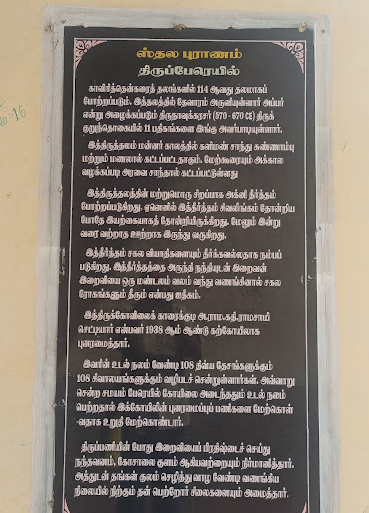This place dates back to the Sangam period. The Sangam-era poetess "Pereyil Muruvalar," known for her contributions to Kurunthogai and Purananooru, hailed from this region. According to historians, when Thiruvarur served as the capital of the Chozhas, a fort existed near this location, which led to the name "Pereyilur." Over time, this evolved into the current name, "Peraiyur."
Since Thirunavukkarasu Swamigal sang hymns in praise of Lord Shiva at this temple, it is believed that the original temple existed before the 7th century. The temple was later reconstructed with stone during the Chozha period and further extended during the Vijayanagara rule. The Nattukottai Nagarathars have maintained it over the years.
Sthala Puranam :

This ancient temple, located in Pereyil, dates back over 2000 years. However, much of its puranic history has been lost over time. During the early Chola period, when Tiruvarur was the capital, Pereyil was believed to have been a fort. The presiding deity, Lord Shiva, is a swayambhu murti (self-manifested lingam). Thirunavukkarasar (Appar) has sung hymns in praise of this temple.
Lord Shiva is said to have blessed all the Devas in this sacred place, which is why He is revered as Jagadeeswarar, the "Lord of the World." Goddess Parvati, in turn, is worshipped as Jagannayaki Amman.
Bathing in the temple tank is believed to cure devotees suffering from leukaemia. Though originally constructed by the Cholas, the temple is now maintained by the Nagarathar community. The temple, while small, features remarkable sculptures and architecture, particularly the stunning image of Sabapathi Natarajar.
A local poetess, Muruvalar, from the Sangam period, has composed verses that appear in Kurunthogai and Purananuru, further emphasising the temple’s significance.
The temple holds two major annual festivals—Tiruvadhirai in Margazhi (December-January) and Maha Shivaratri. Lord Muruga is also venerated here, with the Chithirai Sashti festival celebrated with great devotion.
Administration History :
The administration of the Jagadeeswarar Temple in Ogaiperaiyur has evolved over centuries, reflecting its historical significance and cultural heritage. Originally maintained during the Chola dynasty, the temple underwent renovations and expansions under subsequent rulers, including the Vijayanagar Empire. In modern times, the upkeep of the temple has been entrusted to the Nattukottai Nagarathar community, known for their dedication to preserving religious sites. They have actively contributed to various restoration efforts and rituals, ensuring the temple remains a vibrant centre of worship. The involvement of local devotees has also played a crucial role in maintaining the temple's traditions and practices. Today, the temple continues to thrive as a testament to the rich spiritual legacy of the region.
